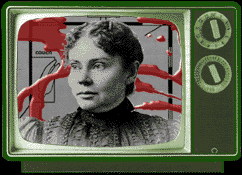

Jump to Section 2 | Section 3 | Section 4 | Section 5 | Section 6 | Bibliography
Section 1
Those who achieve fame in America tend to wind up on television, one way or another, even if they predated the technology. In 1893, the journalist Edwin Porter wrote of the "unparalleled monstrosity of the crime" (4) he covered in Fall River, Massachusetts.
Lizzie Borden, the woman accused of this heinous deed, was catapulted with alarming rapidity from obscurity to national and even world-wide notoriety. Rather than sinking back into anonymity, as is the case with so many other sensational crimes, the story grew and flourished. Lizzie found an enduring position in American popular culture as our pre-eminent axe murderess, the prototype, moving from history to mythic stature. Never mind that her guilt was never proved. Over the course of a century she became the subject of biographical, true-crime narratives, novels, plays, poems, a ballet, an opera, and a made-for-television movie.
The producers of texts are also consumers, and it is possible to see the influence of earlier works in those succeeding them. Images of Lizzie take on solidity through repetition. Phrases and patterns are echoed by writers claiming to have produced the final, definitive version of the story, only to be displaced a few years later. The figure of Lizzie so familiar to us did not emerge full-blown in 1892, but is the product of years of construction. And an odd, paradoxical figure it is. As the monstrous murderer of her two defenseless old parents, she is enshrined in the upper reaches of evil, along with Jack the Ripper. But because she was a woman, and a genteel one at that, a creature least likely to become a criminal, according to cultural stereotypes, she exerts a strong fascination. Lizzie embodies both deadly daughter and harmless spinster aunt. These qualities and her classic story have attracted many fans, and there are no signs that interest is abating. When the owners of the house where the murders occurred announced plans in July, 1995, to turn the place into a bed and breakfast establishment, they got national press coverage, and appeared on a morning network TV news show. People are already inquiring about reservations, some for honeymoon stays, a gesture which perfectly illustrates the strange place Lizzie holds in the popular imagination.
Given such popularity in a wide cross section of media over the decades, it was only a matter of time before Lizzie reached the television screen in a substantial vehicle. Earlier, a story about the Borden case appeared on Alfred Hitchcock Presents in 1956 (Flynn 83-4). I can think of numerous allusions to Lizzie over the years on a variety of programs. When there is an axe mentioned, Lizzie is often the one holding it. The most thorough treatment of the Borden case came in 1974, in William Bast's made-for-TV movie, The Legend of Lizzie Borden, starring Elizabeth Montgomery, who even resembles the photographs of the historical Lizzie. At present, the movie is not available commercially, but since its network premiere, it has received a lot of play on cable, and reached a wide audience.
Not only is the movie entertaining, but it also contains and raises several important issues which are elements in other Borden texts as well, and which continue to keep Lizzie both problematical and fascinating. They involve questions about history and legend and their relation to the biographical subject, about gender and class, and about audience response. All of these are worth exploring.
The film begins with the day of the murders and ends with Lizzie returning home after the trial. It opens with the statement that it is "based largely on fact," rather a curious claim for a film with "legend" in its title, but that is the paradoxical nature of representations of Lizzie. I suppose that it could be disingenuously argued that the legend is being factually rendered, but actually, claims to truth are being made. One does not have to be familiar with the Borden case to see that plenty of conjecture is also worked into the film, the most stunning being Lizzie's execution of the murders onscreen. This is a breathtaking bit of artistic license, since all we know is that the murders occurred and that Lizzie was accused. The central and most sensational scenes in the film are fiction, but fall under the rubric of the opening statement. They reaffirm the legend, situated somewhere between history and myth.
The few indisputable historical facts are these. Lizzie and Emma Borden were spinsters living with their father Andrew and stepmother Abby in a cramped house in downtown Fall River. Andrew was a rich, successful, and influential businessman, and a well-known miser. Both "girls" were ladies of spotless reputation. Lizzie was active in church work and the Women's Christian Temperance Union, but there is no record of any feminist associations. On August 4, 1892, the elder Bordens were brutally murdered by many blows to the head. Only Lizzie and Bridget Sullivan, the maid, were in the house with them that fatal morning. The weapon was never found, but suspected to be an axe. Lizzie was accused of the crime and imprisoned. She was tried in June, 1893, and acquitted. She and Emma inherited Andrew's considerable wealth. No one else was ever accused of the murders.